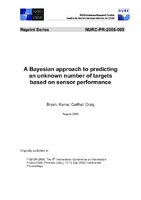| dc.contributor.author | Bryan, Karna | |
| dc.contributor.author | Carthel, Craig | |
| dc.date.accessioned | 2018-10-11T14:09:26Z | |
| dc.date.available | 2018-10-11T14:09:26Z | |
| dc.date.issued | 2006/08 | |
| dc.identifier | 24982 | |
| dc.identifier.govdoc | NURC-PR-2006-005 | |
| dc.identifier.uri | http://hdl.handle.net/20.500.12489/599 | |
| dc.description.abstract | Estimating remaining targets after some attempt has been made to detect an overall, unknown number of targets is critical to determining the potential threat associated with these remaining targets. This paper presents a Bayesian approach to | |
| dc.description.abstract | calculate the distribution on the number of remaining targets given the sensor performance and the | |
| dc.description.abstract | number of targets detected. For a single sensor, a closed form posterior distribution on remaining targets is derived. For multiple sensors, the corresponding | |
| dc.description.abstract | posterior distribution is developed. A naive implementation of this calculation is shown to be computationally prohibitive, and an efficient means for performing the calculation is presented. | |
| dc.format | 11 p. : ill. : digital, PDF file | |
| dc.language | English | |
| dc.publisher | NURC | |
| dc.source | In: FUSION 2006, The 9th International Conference on Information | |
| dc.source | Fusion 2006, Florence (Italy), 10-13 July 2006, Conference | |
| dc.source | Proceedings. | |
| dc.subject | Sensor management | |
| dc.title | A Bayesian approach to predicting an unknown number of targets based on sensor performance | |
| dc.type | Reprint (PR) | |
| dc.type | Papers and Articles | |
